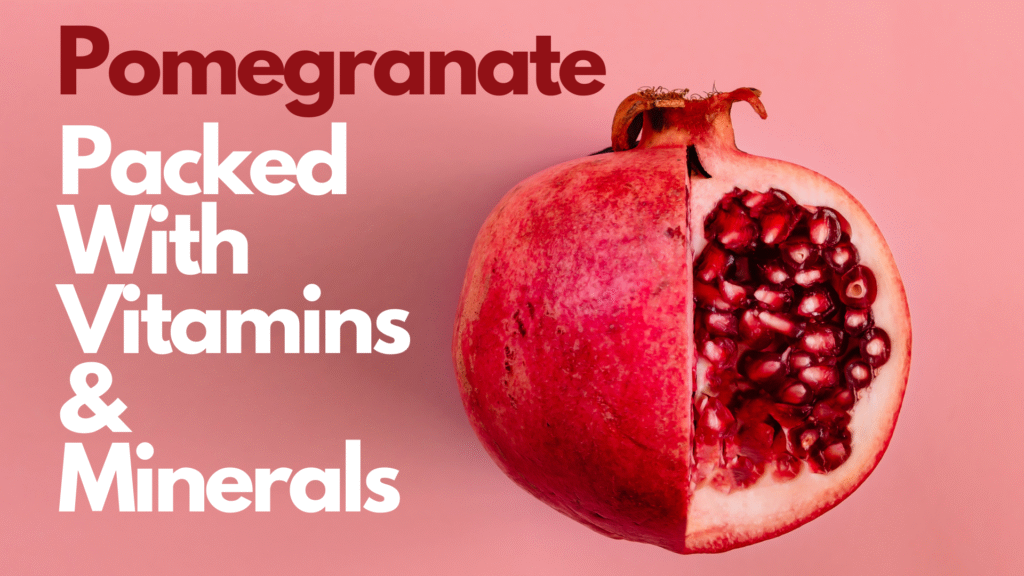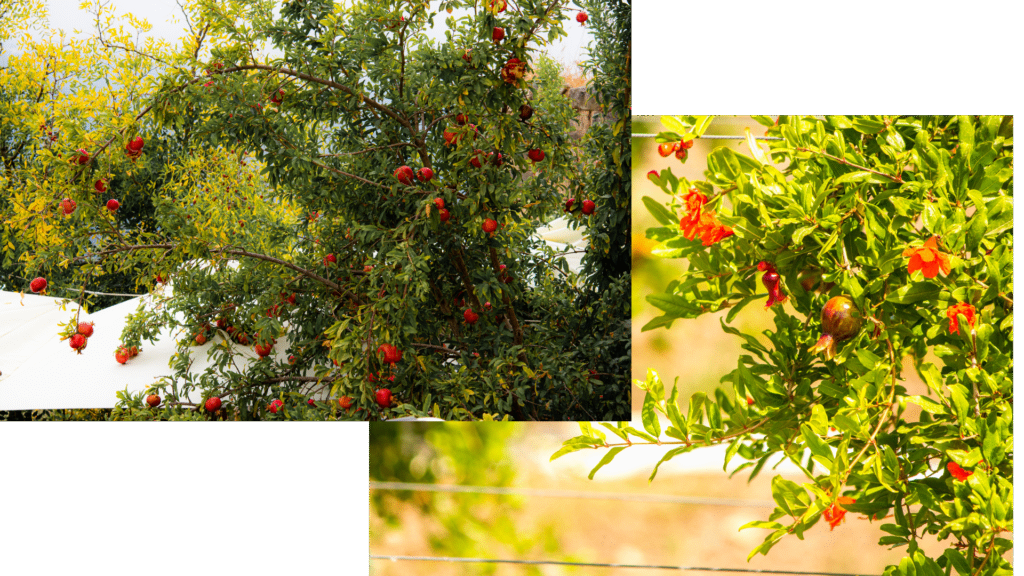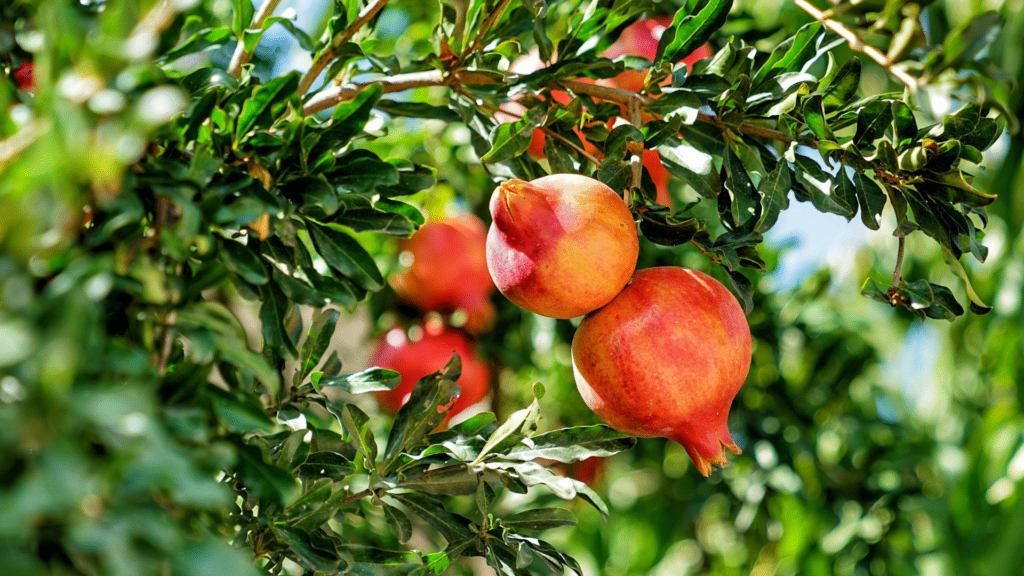How To Plant Pomegranate | Punica granatum
About Pomegranate Trees
Let’s talk about how to pomegranate. Originally from the Mediterranean region, this amazing fruit tree was brought to California by Spanish settlers in 1769. Since then, it can be found in most American regions, but the fruit it will bear depends on where the tree is located. Northern American areas can start harvesting fruit in October, and continue to harvest until February, where most Southern American regions can start harvesting in March, and harvest until May.
This tree is becoming very popular across America. Eating just 3.5 oz of the edible portion of the raw gems gives us about 80 kcals of goodness. Almost 19 g of complex carbohydrates, compacted with 4 g of dietary fiber, this little fruits gems are delicious and very nutritious. It is the perfect snack containing vitamins and minerals galore. Packed with zinc, potassium, magnesium, manganese, vitamins B, C, E, and K, it is no wonder why this fruit is leading the health parade.

Pomegranate Varieties
Keep in mind, no matter what variety of tree you choose to grow, it will take at least two years before the first crop can be harvested. After an established tree has been undisturbed in a spot for at least one year, it should start to form and ripen its’ fruit. Although, this could take as long as three years. Now let’s talk about the different varieties.
- Nana – This is the smallest of all the varieties. At just over 3 feet in height, this variety is also the best adapted for cooler climates. Often used in landscaping or as border plants, they do produce smaller fruit, and eating them is not considered to be very good. So if your plan is to grow and harvest edible pomegranates, you should select another variety.
- Wonderful – The most commonly found pomegranate across the country. This is the one found in most grocery stores and makes up 95% of the US pomegranate consumer market. Chances are if you’ve ever eaten a pomegranate, it was a Wonderful pomegranate you enjoyed. This tree enjoys dry warmer weather, but can tolerate some colder areas. The Wonderful Pomegranate tree yields a lot of beautiful fruit, so this might be the right tree for you if you are looking to consume from your tree.
- Sweet – This tree variety produces fruit early in the season. These little gem fruits are often much sweeter than the Wonderful tree variety, and you can expect a very successful harvest from these pomegranate trees. Although, their taste may not be what you are expecting. As the name suggests, they are sweeter, and not as tart as many of us are use to.
How To Grow Pomegranate
One of the most important things to remember about this tree is it does not like the cold, especially if it it has recently been transplanted or is still really young. When transplanting this tree, have good soil that is not packed down so the roots can become established. If the soil is too compacted, or you have not turned the soil, it is recommended you do. At the same time, it would be best if you integrated some compost. Again, make sure this is done after the last frost because it could shock the roots, or break down the tree causing pest or disease.
Shock could also slow down or stop the growth of your trees for several weeks or months, even if they are able to survive the cold weather. If you are planning to have a couple or many trees, you want at least 15-20 feet between each tree. If your plan is to have pomegranate trees for landscaping, and want smaller ornamental shrubs for borders, your spacing can be only 6 – 9 feet apart.
The trees like to have enough room to spread out above ground, but the roots need to have their own space which generally corresponds to the drip line of the tree. If you are unsure where you should plant your tree, select a part of the yard that has at least 6-hours of direct sunlight. Again, they like warmer weather. The area you choose can be partially shaded, but you do not want to plant them in full shade since pomegranates enjoy sun. If you can plant them in a location that gets even more than the recommended 6-hours, your pomegranates will do even better.
Pomegranate trees should be pruned at the end of winter before new bud begin but after last frost. For more information check out How to Prune a Pomegranate Tree in the Gro Guide.
Growing conditions
You have successfully planted your new pomegranate tree, good for you. Now it is time to care for it. You want to make sure the tree will have adequate water. Even though this tree can tolerate to some drought, it is very important it does not experience this the first couple months after a transplant. After they have rooted in and are established in the soil after a couple months, not watering will be a part of its growth. But until then, keep the soil moist, and the tree free of drought. I recommend starting with a drip irrigation system to help you for the first 6-8 months.
Just like too little water at the beginning can be detrimental, too much watch can cause problems as well. Because pomegranate trees have a high drought tolerance, watering them too much can cause all kinds of disease from fungus which can kill the tree, or make them unsuitable to bear fruit.
Growing Pomegranate From Seeds
If you want to start your pomegranate tree from seed, by all means go for it. But honestly, it might make you more stressed and unset. Starting pomegranate trees from seeds is a very slow process. Germinating alone can take 30-45 days. Then from that point to become a small viable two leaf bud could take another 30 days. But if you want to, then start with a pomegranate, and cut it in half.
Using a spoon, scoop out the seeds leaving as much of the individual caverns as possible. Take that half and fill with dirt, compost, or peat moss. Water well to let all the material settle down in the cavity and shell. Now place the seeds in the prepared soil about ½ inch down, and cover as needed. Keep the mixture moist at all times. Once they are strong enough to transplant into a larger container do so.
Once they have taken to the transplant, it is time to “harden” the plants before you can transplant them outside. As I said before, water them well, but do not drench. Once they are ready to transplant outside, follow the segment on how to grow pomegranates to continue rearing the tree.

How to Harvest Pomegranate
It is very exciting to see the flowers on your tree turn into little balls of light red delight. Now is the time to wonder when you can harvest these little suckers to eat. Well, first you want the color of the fruit to get darker, and resemble more of the color they look like in the stores. You do not want to harvest the fruit if it looks glossy or shiny.
If the colors have changed, check the shape of the fruit. Ripe fruits will look longer and have more of a hexagon shape to them, with corners instead of being rounded. Finally, you want to tap your finger against the pomegranate and see if there are sounds that bounce back. It will sound tinny or can even sound slightly metallic. If your pomegranate fruits meet all of these criteria, then it is time to harvest the fruit.
Also, I want to add that pomegranate trees are self-incompatible. This means you need to have two pomegranate trees to make the fruit. If you only have one tree, the flowers cannot be fertilized and the tree will not produce fruit. Remember, you need two pomegranate trees to fertilize the flowers to produce the fruit.
Have questions about Cutting a Pomegranate? Check out the Gro Guide article How to Cut a Pomegranate.

Pests and Disease
Pomegranate trees are highly resistant to pest and diseases. This hardiness makes them a blessing to have in your garden and yard. But, just like healthy people when we get sick, trees can get sick, when stressed they will be more susceptible to infection and disease. Stress is the number one killer in people and it is the same when it comes to pomegranate trees. Keeping your tree healthy will go a long way!
You should make it a practice to always look at all your gardening plants, and make no exception with this tree. Catching common pest before they become a problem can save your fruit and tree. Some common pests include:
- Scales
- Mealy Bugs
- Whiteflies
- Pomegranate Butterflies
These pests take advantage of your trees shrubs and branches that have not been properly pruned. They will feed on diseased branches and then get into the branches and bark, causing major disaster.
If you over-water, you can expect diseases like:
- Soft rot
- Fruit spots that are caused by fungal infections.
If this happens to you, consider using an organic fungicide and insecticide on your trees weekly. This will help to prevent either of these diseases from taking over and destroying the trees.
Do you eat pomegranate seeds?
Yes, you definitely eat the pomegranate seeds. I highly do not recommend eating any other part of the fruit. It could be toxic and bad for your system. The seeds, the juice and the shell containing them both are very nutritious and delicious.
Do Pomegranates make you poop?
Pomegranate seeds are packed with fiber. 1 cup of seeds contains 7 grams of fiber. So I would say "yea, pomegranates will help you have a bowel movement." Not only will they help you stay regular, but they are packed with vitamins and minerals too.
Does pomegranate juice make you poop?
Filled with 3.5 grams of soluble and in-soluble fiber per 1/2 a cup, pomegranate will help you have regular bowel moments. As with all seeds and nuts be mindful on how much you are eating.
What part of a pomegranate is poisonous?
Just because something is not poisonus, doesn't mean you should eat it. This fruit it no exception. The stem, peel, and roots can be very unsafe to eat and poisonous. If by chance your child or animal eats some of the peel, call poision control.

